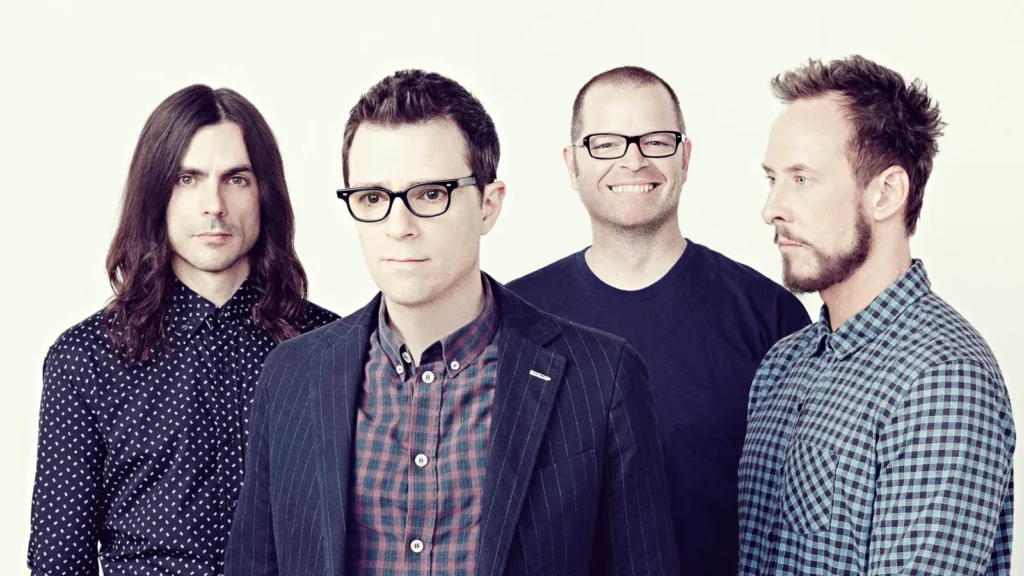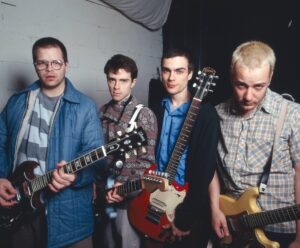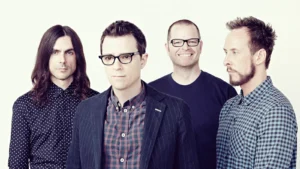
The Evolution of Weezer: From Geek Rock to Genre Chameleons”2025
Yes, that Weezer — the band that gave us “Buddy Holly,” “Say It Ain’t So,” and also a very serious, unironic cover of “Africa” by Toto. Over the last few decades, Weezer has gone from awkward alt-rock darlings to one of the most unpredictable, genre-bouncing bands in modern music. And honestly? It’s been a wild ride.
This is the story of how Weezer went from geek rock legends to full-blown musical chameleons — whether we asked for it or not.
1994–1996: The Geek Rock Crown

The Weezer origin story starts with The Blue Album (1994), a power-pop masterpiece that defined a generation of flannel-clad, emotionally repressed teenagers. It was crunchy, melodic, and packed with just enough weird to make you feel like you were in on a secret.
Rivers Cuomo, the frontman/genius/chaotic neutral energy at the center of it all, was nerdy in a way that wasn’t performative — it was just him. And that authenticity (plus the Spike Jonze-directed “Buddy Holly” video) helped launch them into alt-rock stardom.
Then came Pinkerton (1996). Raw. Messy. Confessional. And at the time? A commercial and critical flop. But in the years since, it’s become a cult classic — a cornerstone of modern emo. Who knew we’d all be screaming “I’m tired, so tired” in our 30s
2001–2005: Shiny Pop Rock & Radio Hits

After a brief hiatus and a beard-growing period for Rivers, Weezer came back with The Green Album (2001). Gone were the messy emotions of Pinkerton — replaced by tight, radio-friendly tracks like “Hash Pipe” and “Island in the Sun.” It was simple. It was catchy. It was a reset button.
From there, they leaned further into the mainstream with Maladroit and Make Believe. “Beverly Hills” may have been critically roasted, but it somehow became a frat-party staple and their first real chart-topper. Go figure.
Jack Draper Shines
2008–2010: Getting Weird on Purpose

This era was… chaotic.
With The Red Album (2008), Weezer went full self-aware internet band. “Pork and Beans” came with a viral YouTube-heavy video, and Rivers let other band members take lead vocals. Strange times.
Raditude (2009) featured a track called “Can’t Stop Partying” with Lil Wayne. I’ll let that sink in.
And then there was Hurley (2010), named after the guy from Lost. Why? Because Weezer does what Weezer wants.
2014–2016: The Return of “Classic” Weezer

After a few years of fans yelling “just make another Blue Album,” Weezer listened — kinda.
Everything Will Be Alright in the End (2014) felt like a true return to form. Anthemic riffs, heartfelt lyrics, and that awkward charm we all missed. The White Album (2016) followed suit — sunny, surfy, and full of that classic California melancholy.
Critics started giving them love again. Longtime fans breathed a sigh of relief. It felt like the old Weezer was back… but only for a bit.
dpv nation
2017–2021: Genre Roulette

Now Weezer was out here doing whatever the hell they wanted.
Pacific Daydream (2017) brought in dream-pop vibes. Then they dropped The Teal Album — a full album of covers, from “Take On Me” to “No Scrubs.” And yes, “Africa” by Toto. It was weird. It was meme-worthy. It worked.
But then came Black Album (2019), which veered into glossy, synthy, experimental pop — and left a lot of fans scratching their heads.
Just to confuse us further, 2021 brought two polar opposite albums:
- OK Human — a surprisingly beautiful, orchestral, introspective project.
- Van Weezer — a full-blown, guitar-shredding tribute to ‘80s arena rock. Yes, the same year. Why not?
2022–Now: Four Seasons and Total Freedom

In classic Weezer fashion, they launched a bold new concept in 2022: SZNZ — four season-themed EPs (Spring, Summer, Autumn, Winter). Each one sounded different. Each one felt like Rivers experimenting in his musical laboratory with zero restraints.
Folk, synth-pop, baroque arrangements, even Gregorian chant vibes. It’s the most Rivers Cuomo thing imaginable — and while not every track lands, it’s ambitious as hell.
Final Thoughts: The Only Constant Is Chaos (and Catchy Hooks)
Weezer is polarizing. Always has been. Always will be.
Some fans just want Blue and Pinkerton forever. Others (like me) enjoy the chaos — you never know what kind of Weezer you’re getting next. Arena rock? Emo revival? A cover of Michael Jackson’s “Billie Jean.





